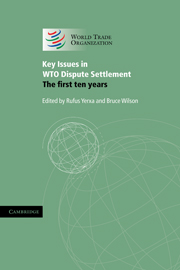Book contents
- Frontmatter
- Contents
- Notes on contributors
- Preface
- Table of cases
- Abbreviations
- PART I Introduction and General Considerations
- PART II The WTO Dispute Settlement System: Its Processes and Its Institutions
- 3 The WTO dispute settlement system and its operation: a brief overview of the first ten years
- 4 The role of the Dispute Settlement Body in the dispute settlement process
- 5 Consultations and the panel process in the WTO dispute settlement system
- 6 Contingent trade remedies and WTO Dispute Settlement: some particularities
- 7 The making of the ‘World Trade Court’: the origins and development of the Appellate Body of the World Trade Organization
- 8 Special challenges at the appellate stage: a case study
- 9 The reasonable period of time for compliance with rulings and recommendations adopted by the WTO Dispute Settlement Body
- 10 Implementation of panel and Appellate Body rulings: an overview
- 11 A brief introduction to countermeasures in the WTO dispute settlement system
- PART III The WTO Dispute Settlement System: Systemic and Other Issues
- PART IV Annexes
5 - Consultations and the panel process in the WTO dispute settlement system
from PART II - The WTO Dispute Settlement System: Its Processes and Its Institutions
Published online by Cambridge University Press: 04 August 2010
- Frontmatter
- Contents
- Notes on contributors
- Preface
- Table of cases
- Abbreviations
- PART I Introduction and General Considerations
- PART II The WTO Dispute Settlement System: Its Processes and Its Institutions
- 3 The WTO dispute settlement system and its operation: a brief overview of the first ten years
- 4 The role of the Dispute Settlement Body in the dispute settlement process
- 5 Consultations and the panel process in the WTO dispute settlement system
- 6 Contingent trade remedies and WTO Dispute Settlement: some particularities
- 7 The making of the ‘World Trade Court’: the origins and development of the Appellate Body of the World Trade Organization
- 8 Special challenges at the appellate stage: a case study
- 9 The reasonable period of time for compliance with rulings and recommendations adopted by the WTO Dispute Settlement Body
- 10 Implementation of panel and Appellate Body rulings: an overview
- 11 A brief introduction to countermeasures in the WTO dispute settlement system
- PART III The WTO Dispute Settlement System: Systemic and Other Issues
- PART IV Annexes
Summary
General features of the WTO dispute settlement system
The WTO dispute settlement system is a rules-based system as opposed to a negotiation-conciliation-mediation type of dispute resolution mechanism. The system includes procedural steps that can be triggered by any WTO Member dissatisfied with another Member's measure considered to be inconsistent with any provision of the WTO Agreement. The system allows the dissatisfied Member to obtain a legal ruling by an independent adjudicative body on its rights and obligations under the relevant agreements. The dispute settlement system of the WTO is thus quasi-judicial: independent and autonomous bodies are responsible for adjudication of disputes although formally subject to the overall authority of the Dispute Settlement Body (DSB). The jurisdiction of the DSB and therefore that of the adjudicating bodies (i.e. panels and the Appellate Body) operating under its authority has been accepted by all WTO Members through their ratification of the WTO treaty. Thus, a WTO Member cannot refuse to participate in a WTO dispute settlement procedure if a complaint is brought against it.
The WTO dispute settlement system is quasi-automatic because it operates on the basis of 'reverse, or negative, consensus'. WTO-related disputes once triggered, the process can only be stopped with the consent of all parties to the dispute. Application of the principle of automaticity to the legal steps of the dispute settlement system has evolved from the early days of the General Agreement on Tariffs and Trade (GATT).
- Type
- Chapter
- Information
- Key Issues in WTO Dispute SettlementThe First Ten Years, pp. 29 - 45Publisher: Cambridge University PressPrint publication year: 2005
- 2
- Cited by



